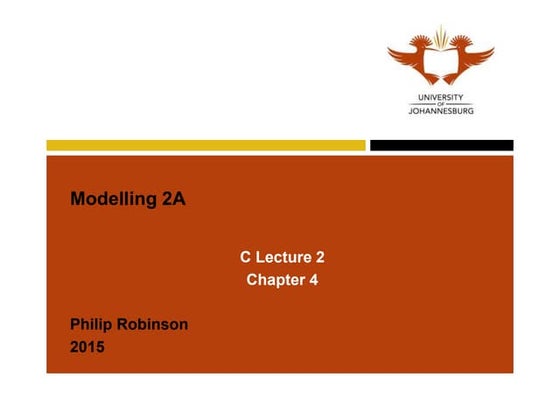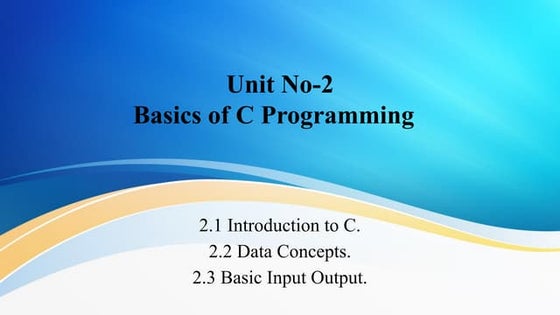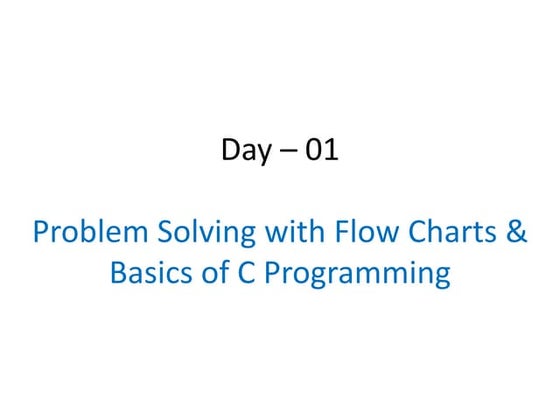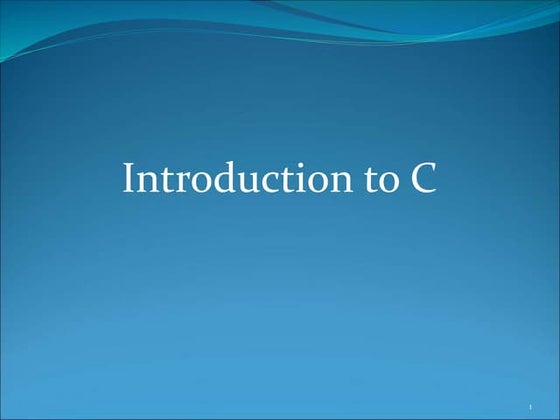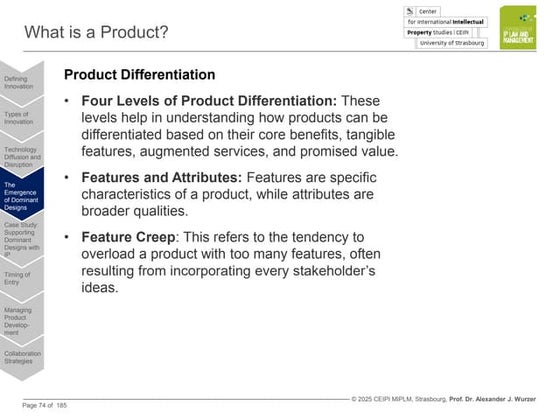Elementary_Of_C++_Programming_Language.ppt
- 1. Elementary C Elementary C+ + + + Programming Programming panupong@kku.ac.th panupong@kku.ac.th
- 2. 2 // Sample program // Reads values for the length and width of a rectangle // and returns the perimeter and area of the rectangle. #include <iostream.h> void main() { int length, width; int perimeter, area; // declarations cout << "Length = "; // prompt user cin >> length; // enter length cout << "Width = "; // prompt user cin >> width; // input width perimeter = 2*(length+width); // compute perimeter area = length*width; // compute area cout << endl << "Perimeter is " << perimeter; cout << endl << "Area is " << area << endl; // output results } // end of main program
- 3. 3 The following points should be The following points should be noted in the above program: noted in the above program: ⢠Any text from the symbols // until the end of the line is ignored by the compiler. ⢠The line #include <iostream.h> This statement is a compiler directive -- that is it gives information to the compiler but does not cause any executable code to be produced.
- 4. 4 The following points should be The following points should be noted in the above program: noted in the above program: ⢠The actual program consists of the function main which commences at the line void main() All programs must have a function main. ⢠The body of the function main contains the actual code which is executed by the computer and is enclosed, as noted above, in braces {}.
- 5. 5 The following points should be The following points should be noted in the above program: noted in the above program: ⢠Every statement which instructs the computer to do something is terminated by a semi-colon ;. ⢠Sequences of characters enclosed in double quotes are literal strings. Thus instructions such as cout << "Length = " send the quoted characters to the output stream cout.
- 6. 6 The following points should be The following points should be noted in the above program: noted in the above program: ⢠All variables that are used in a program must be declared and given a type. In this case all the variables are of type int, i.e. whole numbers. Thus the statement int length, width; ⢠Values can be given to variables by the assignment statement, e.g. the statement area = length*width;
- 7. 7 The following points should be The following points should be noted in the above program: noted in the above program: ⢠Layout of the program is quite arbitrary, i.e. new lines, spaces etc. can be inserted wherever desired and will be ignored by the compiler.
- 8. 8 Variables Variables ⢠A variable is the name used for the quantities which are manipulated by a computer program. ⢠In order to distinguish between different variables, they must be given identifiers, names which distinguish them from all other variables.
- 9. 9 The rules of C++ for The rules of C++ for valid identifiers valid identifiers ⢠An identifier must: â start with a letter â consist only of letters, the digits 0-9, or the underscore symbol _ â not be a reserved word Reserved words are otherwise valid identifiers that have special significance to C++. ⢠use of two consecutive underscore symbols, __, is forbidden.
- 10. 10 Identifiers Identifiers ⢠The following are valid identifiers Length days_in_year DataSet1 Profit95 Int_Pressure first_one first_1 ⢠although using _Pressure is not recommended. ⢠The following are invalid: days-in-year 1data int first.val throw
- 11. 11 Identifiers Identifiers ⢠Identifiers should be meaningful ⢠C++ is case-sensitive. That is lower- case letters are treated as distinct from upper-case letters. ⢠Thus the word main in a program is quite different from the word Main or the word MAIN.
- 12. 12 Reserved words Reserved words and and_eq asm auto bitand bitor bool break case catch char class const const_cast continue default delete do double dynamic_cast else enum explicit export extern false float for friend goto if inline int long mutable namespace new not not_eq operator or or_eq private protected public register reinterpret_cast return short signed sizeof static static_cast struct switch template this throw true try typedef typeid typename union unsigned using virtual void volatile wchar_t while xor xor_eq
- 13. 13 Declaration of variables Declaration of variables ⢠In C++ all the variables that a program is going to use must be declared prior to use. ⢠Declaration of a variable serves two purposes: â It associates a type and an identifier (or name) with the variable. The type allows the compiler to interpret statements correctly. â It allows the compiler to decide how much storage space to allocate for storage of the value associated with the identifier and to assign an address for each variable which can be used in code generation.
- 14. 14 Variable Types Variable Types ⢠int ⢠float ⢠bool ⢠char
- 15. 15 int int ⢠int variables can represent negative and positive integer values (whole numbers). ⢠There is a limit on the size of value that can be represented, which depends on the number of bytes of storage allocated to an int variable by the computer system and compiler being used. ⢠On a PC most compilers allocate two bytes for each int which gives a range of -32768 to +32767. ⢠On workstations, four bytes are usually allocated, giving a range of -2147483648 to 2147483647. ⢠It is important to note that integers are represented exactly in computer memory.
- 16. 16 float float ⢠float variables can represent any real numeric value, that is both whole numbers and numbers that require digits after the decimal point. ⢠The accuracy and the range of numbers represented is dependent on the computer system. ⢠Usually four bytes are allocated for float variables, this gives an accuracy of about six significant figures and a range of about -1038 to +1038 . ⢠It is important to note that float values are only represented approximately.
- 17. 17 bool bool ⢠bool variables can only hold the values true or false. ⢠These variables are known as boolean variables in honour of George Boole, an Irish mathematician who invented boolean algebra.
- 18. 18 char char ⢠char variables represent a single character -- a letter, a digit or a punctuation character. ⢠They usually occupy one byte, giving 256 different possible characters. ⢠The bit patterns for characters usually conform to the American Standard Code for Information Interchange (ASCII).
- 19. 19 Examples of values for such Examples of values for such variables are: variables are: ⢠int 123 -56 0 5645 ⢠float 16.315 -0.67 31.567 ⢠char '+' 'A' 'a' '*' '7'
- 20. 20 Variable Declarations Variable Declarations ⢠A typical set of variable declarations that might appear at the beginning of a program could be as follows: int i, j, count; float sum, product; char ch; bool passed_exam; ⢠which declares integer variables i, j and count, real variables sum and product, a character variable ch, and a boolean variable pass_exam.
- 21. 21 A variable declaration has A variable declaration has the form: the form: type identifier-list; ⢠Type specifies the type of the variables being declared. ⢠The identifier-list is a list of the identifiers of the variables being declared, separated by commas ⢠Variables may be initialized at the time of declaration by assigning a value to them
- 22. 22 Examples Examples int i, j, count = 0; float sum = 0.0, product; char ch = '7'; bool passed_exam = false;
- 23. 23 Constants and the Constants and the declaration of constants declaration of constants ⢠Often in programming numerical constants are used, e.g. the value of ¶. ⢠It is well worthwhile to associate meaningful names with constants. ⢠These names can be associated with the appropriate numerical value in a constant declaration. ⢠The names given to constants must conform to the rules for the formation of identifiers as defined above.
- 24. 24 Constants and the Constants and the declaration of constants declaration of constants const int days_in_year = 365; â defines an integer constant days_in_year which has the value 365. â Later in the program the identifier days_in_year can be used instead of the integer 365, making the program far more readable. The general form of a constant declaration is: const type constant-identifier = value ;
- 25. 25 General form of a C++ General form of a C++ Program Program // Introductory comments // file name, programmer, when written or modified // what program does #include <iostream.h> void main() { constant declarations variable declarations executable statements }
- 26. 26 Input and Output Input and Output ⢠Input and output use the input stream cin and the output stream cout. ⢠The input stream cin is usually associated with the keyboard ⢠The output stream cout is usually associated with the monitor.
- 27. 27 cin cin The following statement waits for a number to be entered from the keyboard and assigns it to the variable number: cin >> number; The general form of a statement to perform input using the input stream cin is: cin input-list; where input-list is a list of identifiers, each identifier preceded by the input operator >>.
- 28. 28 cin cin cin >> n1 >> n2; would take the next two values entered by the user and assign the value of the first one to the variable n1 and the second to the variable n2. User enter 10 20 <ENTER> 10 <ENTER> 20<ENTER> 10 20 30 <ENTER>
- 29. 29 cout cout ⢠The following statement outputs the current value of the variable count to the output stream cout cout << count; ⢠The general form of a statement to perform output using the output stream cout is: cout output-list; where output-list is a list of variables, constants, or character strings in quotation marks, each preceded by the output operator <<.
- 30. 30 cout cout cout << "Hello there" << endl; ⢠will print Hello there on the current output line and then take a new line for the next output.
- 31. 31 Example Example float length, breadth; cout << "Enter the length and breadth: "; cin >> length >> breadth; cout << endl << "The length is " << length; cout << endl << "The breadth is " << breadth << endl; will display, if the user enters 6.51 and 3.24 at the prompt, the following output: The length is 6.51 The breadth is 3.24
- 32. 32 Example Example ⢠Note that a value written to cout will be printed immediately after any previous value with no space between. ⢠In the above program the character strings written to cout each end with a space character. The statement cout << length << breadth; would print out the results as 6.513.24 ⢠which is obviously impossible to interpret correctly. If printing several values on the same line remember to separate them with spaces by printing a string in between them as follows: cout << length << " " << breadth;
- 33. 33 Programming Style Programming Style ⢠any number of spaces and or new lines can be used to separate the different symbols in a C++ program. ⢠The identifiers chosen for variables mean nothing to the compiler either, but using identifiers which have some significance to the programmer is good practice.
- 34. 34 Programming Style Programming Style ⢠The program below is identical to the original example in this Lesson, except for its layout and the identifiers chosen. Which program would you rather be given to modify?
- 35. 35 Programming Style Programming Style #include <iostream.h> void main( ) { int a,b, c,d; cout << "Length = "; cin >> a; cout<<"Width = " ;cin >> b; c = 2*(a+ b); d = a*b; cout << endl << "Perimeter is " << c << endl << "Area is " << d << endl;}
- 36. 36 Summary Summary ⢠All C++ programs must include a function main(). ⢠All executable statements in C++ are terminated by a semi-colon. ⢠Comments are ignored by the compiler but are there for the information of someone reading the program. All characters between // and the end of the line are ignored by the compiler. ⢠All variables and constants that are used in a C++ program must be declared before use. Declaration associates a type and an identifier with a variable. ⢠The type int is used for whole numbers which are represented exactly within the computer.
- 37. 37 Summary Summary ⢠The type float is used for real (decimal) numbers. They are held to a limited accuracy within the computer. ⢠The type char is used to represent single characters. A char constant is enclosed in single quotation marks. ⢠Literal strings can be used in output statements and are represented by enclosing the characters of the string in double quotation marks ". ⢠Variables names (identifiers) can only include letters of the alphabet, digits and the underscore character. They must commence with a letter. ⢠Variables take values from input when included in input statements using cin >> variable-identifier. ⢠The value of a variable or constant can be output by including the identifier in the output list cout << output- list. Items in the output list are separated by <<.
- 38. 38 Hello World Hello World #include <iostream.h> // This program prints // âHello World.â int main() { cout << "Hello World.n"; return 0; }
- 39. 39 Exercises Exercises 1 1 Using literal character strings and cout print out a large letter E as below: XXXXX X X XXX X X XXXXX
- 40. 40 Exercises Exercises 2 2 Write a program to read in four characters and to print them out, each one on a separate line, enclosed in single quotation marks.
- 41. 41 Exercises Exercises 3 3 Write a program which prompts the user to enter two integer values and a float value and then prints out the three numbers that are entered with a suitable message.
- 43. 43 The Assignment statement The Assignment statement ⢠The main statement in C++ for carrying out computation and assigning values to variables is the assignment statement. ⢠For example the following average = (a + b)/2; ⢠assigns half the sum of a and b to the variable average.
- 44. 44 The Assignment statement The Assignment statement ⢠The general form of an assignment statement is: result = expression ; ⢠The expression is evaluated and then the value is assigned to the variable result. ⢠It is important to note that the value assigned to result must be of the same type as result.
- 45. 45 The expression The expression ⢠can be a single variable, ⢠a single constant ⢠variables and constants combined by the arithmetic operators. ⢠Rounded brackets () may also be used in matched pairs in expressions to indicate the order of evaluation.
- 46. 46 Arithmetic Operators Arithmetic Operators + addition - subtraction * multiplication / division % remainder after division (modulus) i = 3; sum = 0.0; perimeter = 2.0 * (length + breadth); ratio = (a + b)/(c + d);
- 47. 47 The type of the operands of The type of the operands of an arithmetic operator an arithmetic operator The following rules apply: ⢠if both operands are of type int then the result is of type int. ⢠if either operand, or both, are of type float then the result is of type float. ⢠if the expression evaluates to type int and the result variable is of type float then the int will be converted to an equivalent float before assignment to the result variable. ⢠if the expression evaluates to type float and the result variable is of type int then the float will be converted to an int, usually by rounding towards zero, before assignment to the result variable.
- 48. 48 Priority of Operators Priority of Operators a + b * c ⢠be evaluated by performing the multiplication first, or by performing the addition first? i.e. as ⢠(a + b) * c or as a + (b * c) ?
- 49. 49 Priority of Operators Priority of Operators ⢠C++ solves this problem by assigning priorities to operators ⢠Operators with high priority are then evaluated before operators with low priority. ⢠Operators with equal priority are evaluated in left to right order.
- 50. 50 Priority of Operators Priority of Operators ⢠The priorities of the operators seen so far are, in high to low priority order: ( ) * / % + - =
- 51. 51 Priority of Operators Priority of Operators ⢠Thus a + b * c is evaluated as if it had been written as a + (b * c) ⢠because the * has a higher priority than the +. ⢠If in any doubt use extra brackets to ensure the correct order of evaluation.
- 52. 52 Type Conversions Type Conversions ⢠Division of integers will always give an integer result. ⢠If the correct float result is required, then the compiler must be forced to generate code that evaluates the expression as a float. ⢠If either of the operands is a constant, then it can be expressed as a floating point constant by appending a .0 to it, as we have seen.
- 53. 53 Type Conversions Type Conversions ⢠To force an expression involving two int variables to be evaluated as a float expression, at least one of the variables must be converted to float. This can be done by using the cast operation: f = float(i)/float(n);
- 54. 54 Exercise Exercise ⢠Write a program to converts an input value in degrees Fahrenheit to the corresponding value in degrees Centigrade C = 5/9 * (F-32)
- 55. 55 Exercise Exercise ⢠Write a program to converts an input value in pence to the equivalent value in pounds and pence.
- 56. 56 Exercise Exercise ⢠Write a C++ program which reads values for two floats and outputs their sum, product and quotient. Include a sensible input prompt and informative output.
- 57. 57 Summary Summary ⢠Expressions are combinations of operands and operators. ⢠The order of evaluation of an expression is determined by the precedence of the operators. ⢠In an assignment statement, the expression on the right hand side of the assignment is evaluated and, if necessary, converted to the type of the variable on the left hand side before the assignment takes place. ⢠When float expressions are assigned to int variables there may be loss of accuracy.
- 58. Further Further Assignment Assignment Statements & Statements & Control of Output Control of Output
- 59. 59 Increment and Decrement Increment and Decrement Operators Operators ⢠Some operations that occur so frequently in writing assignment statements that C++ has shorthand methods for writing them. ⢠One common situation is that of incrementing or decrementing an integer variable. For example: n = n + 1; n = n - 1;
- 60. 60 Increment and Decrement Increment and Decrement Operators Operators ⢠C++ has an increment operator ++ and a decrement operator --. Thus n++; can be used instead of n = n + 1; n--; can be used instead of n = n - 1; ++n; can be used instead of n = n + 1; --n; can be used instead of n = n - 1;
- 61. 61 Increment and Decrement Increment and Decrement Operators Operators ⢠For example if n has the value 5 then i = n++; would set i to the original value of n i.e. 5 and would then increment n to 6. i = ++n; would increment n to 6 and then set i to 6.
- 62. 62 Specialised Assignment Specialised Assignment Statements Statements ⢠Another common situation that occurs is assignments such as the follows: sum = sum + x; ⢠in which a variable is increased by some amount and the result assigned back to the original variable. ⢠This type of assignment can be represented in C++ by: sum += x;
- 63. 63 Specialised Assignment Specialised Assignment Statements Statements ⢠This notation can be used with the arithmetic operators +, -, *, / and %. ⢠The general form of such compound assignment operators is: variable op= expression which is interpreted as being equivalent to: variable = variable op ( expression )
- 64. 64 Specialised Assignment Specialised Assignment Statements Statements total += value; total = total + value; prod *= 10; prod = prod * 10; x /= y + 1; x = x/(y + 1); n %= 2; n = n % 2;






































































